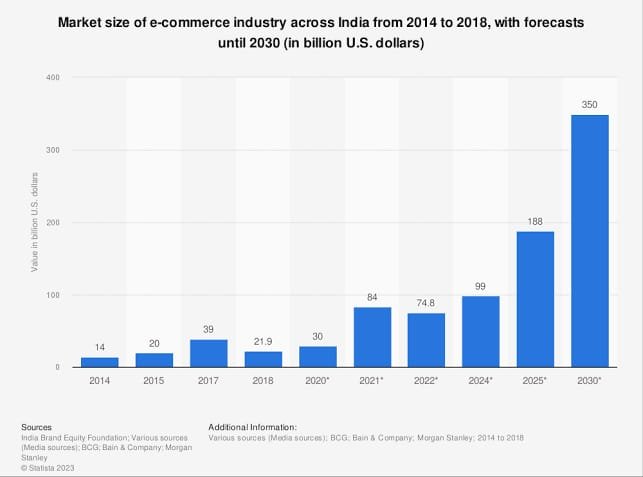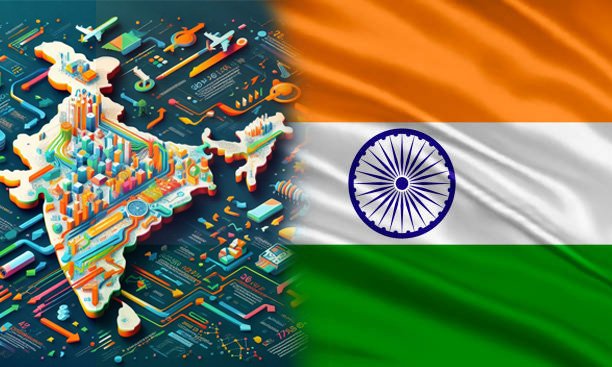Introduction
The future of India in 2030 shines with promise, as the ongoing global digitalization revolution continues to make its impact felt across various work domains. With the pervasive influence of digitization, the nation”s economy is undergoing a profound transformation, shifting all transactions into the realm of digitalization. India”s remarkable progress on the path to becoming an advanced digital nation is evident, showcasing impressive strides. Government projections indicate that by 2030, the digital revolution in India will bring about a momentous economic shift, propelling the digital economy to skyrocket from $175 billion to an astonishing $6 trillion. In fact, a commissioned report by Google and Temasek anticipates a tremendous six-fold growth or a 20% increase in India”s GDP within the next eight years. This exceptional expansion of the digital economy can be attributed to the successful initiatives like Digital India, which have effectively raised awareness and fostered widespread adoption of digital technologies nationwide.
The Revolution in Digital Economy:
India is going to change their economic structure in 2030 by doing great groundwork for enhancing the digital revolution. The Indian economy is tangled with newly developed innovations and high development in the digital economy, which is simply a single industry. The allowance towards going digital resulted in the adaptation of the new things which gave a boost to the economy that increases the whole productivity or capacity.
E Commerce Dominance:
E-commerce dominance in the growing market is the method to gain a greater share of the market with the help of its pre-built dominance over the online business The e-commerce left the mark by presenting its total value of global retail e-commerce sales of $3.45 trillion in 2019.
This is estimated to have 13.7% of the whole global retail sales in 2019.
According to the survey by the big marketers, e-commerce had already reached 31.5% growth in 2021 which is around $45.46 billion in sales.
Emerging online sales businesses will play a huge role in the Indian economy by touching an approximate potential $2.7 billion by 2030.

The Boom of the Gig Economy:
In the last of the period of 1990s, India began to remove its restrictions on the economy which helped in the growth of the private sector in the country. The merging of public and private sectors co-exist in the current scenario and the country leverages international trade. Citizens are getting opportunities to choose a wishful occupation and start their private enterprises.
The government maintains a monopoly in certain trades like defense, banking, power, etc.
By the reports of the Bank’s flagship India was one of the fastest-growing major economies at 7.2% by 22/2 India is on track to become the world’s third-largest economy by 2027, surpassing Japan and Germany.
This may provide a shining result in the upcoming future by gaining the potential of the third-largest stock market by 2030.
India will reach an approximate USD 10 trillion by 2029-2030.
The Indian government is planning with a vision for the economy making it the third-largest economy globally growth and development of the Indian.
Growth of Remote Employment:
The private sector plays a vital role by working as a main job provider in India. At some point in time, every employee wants to work remotely which is largely flexible in private jobs, especially in the IT sector. This figure is reported to be 98% which indicates the extensive growth of work-from-home desire of the employees.
According to the report of FlexJobs remote job is expected to grow tremendously over the next decade.
On average those who work from home spend 10 minutes less a day being unproductive, which results in working one more day a week and increases productivity by 47%.
With the entrance of high-speed internet and the cloud world, the flexibility and productivity of remote work increased exponentially. It has many advantages and more than ever, employees have begun to value jobs that allow flexibility.
In today’s world, 16% of the companies worldwide are 100% remote.
With the growing ecosystem of startups and MNCs, India has become the top choice for companies hiring remote workforce today. According to Microsoft’s annual work trend in India,74% of the employees of India agree to remote work options.
This freedom provides great relief to women to align their work with their life choices.
In the IT sector number of women doubles and contributes a work with 36% of the total workforce.

The Revolution in Digital Education:
In India, the government launched the program Digital India (Third Revolution) on 1 July 2015. The reason to launch that program is to make the citizens of India about the services or benefits they will get after that thing and in the future it will boost or grow the Indian GDP.
In India, the digital education revolution has been going on for the past number of years by making digital places for learning or exploring the new topics that they wanted by replacing the old type of learning.
Under that revolution, both types of students (Urban and Rural) have equal rights or access to higher education with the help of platforms like virtual labs, interactive simulations, augmented reality, Edtech, etc.
Due to this type of revolution Indian youth are now the makers of their accomplishment.
The Urban Living Revolution in Smart Cities:
According to the present development rate, smart cities will be seen in the year 2030. The areas that are urban in the present day become smart cities that possess the power of technology. These type of cities uses the newest technology for the improvement of the management in the urban areas that makes everyday life easier and better for the citizen that lives and work there.
These areas are the combination of the technology and environment.
The main goal of the cities is to make an urban environment with total economic growth.
The importance of privacy and cybersecurity:
In today’s generation dependency of our lives on the internet for online shopping, and socializing for flex over different application create an unknown danger for the user. Huge amounts of sensitive information are stored digitally. Government as well as the private sector need to take the proper measures so that their data is never compromised. The responsibility of the business owners increases as they have to protect their client’s data from data breaches.
In this process, companies have to spend billions of dollars every year.
In 2023 average cost of a data breach marked up to INR 179 million. The most protected data of people is Aadhaar details also get leaked which is in total around 81.5cr.

In conclusion:
It is calculated that a program like Digital India will lift the digital economy of India by $6 trillion or 20% growth in the present time gross domestic product ( GDP ) and may be more around in 2030. Due to the growth in Digital economy the digital literacy also increased in India.
The digital economy is ready to take more weight in the coming time because of the development of technologies like IoT, AI, Blockchain, and Driving Cars.
E-commerce, Gig Economy, remote Jobs, and Smart cities are the main parts that are helping for the growth of the digital economy of India.
The path toward 2030 is not easy, but each one has done its role as a springboard for India to become more globally connected.
A reality that millions of Indians wake up to every day is the digital future.



